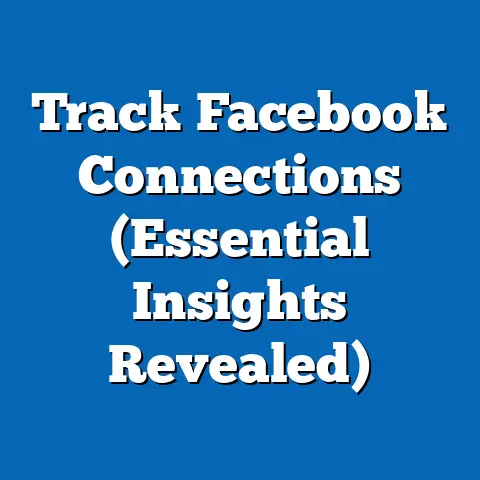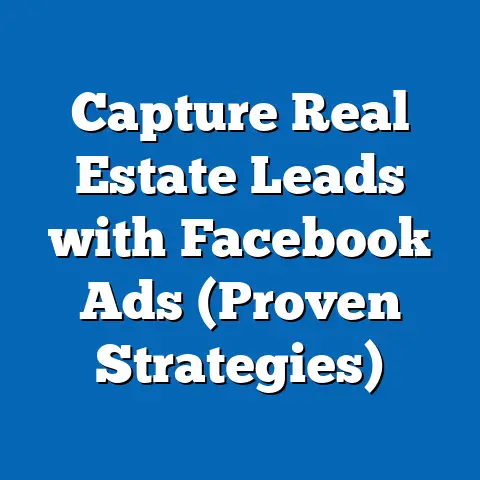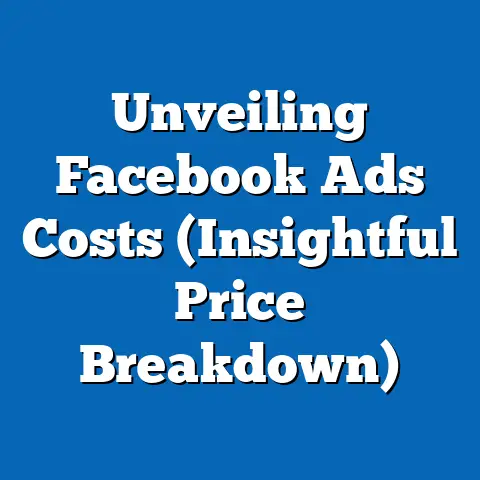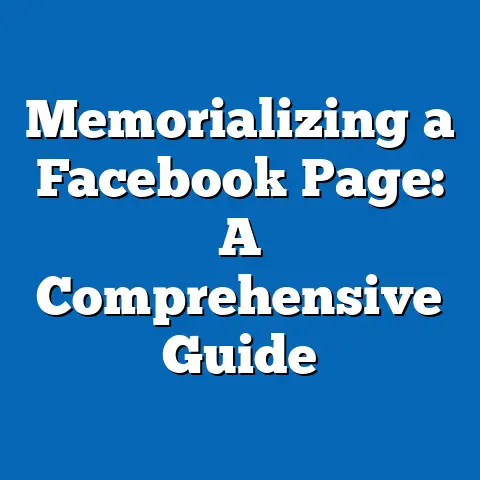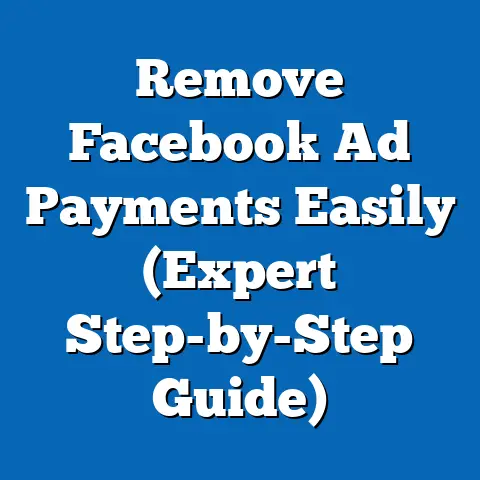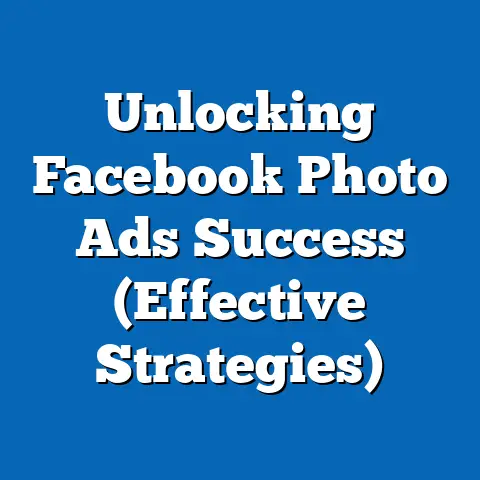Unlocking Effective Facebook Ads (Proven Strategies Revealed)
Imagine Sarah, a passionate small business owner, pouring her heart and soul into her handmade jewelry business. She spent countless hours crafting beautiful pieces, but reaching her target audience felt like shouting into a void. Traditional marketing methods like flyers and local newspaper ads yielded minimal results, leaving her frustrated and questioning her path. Then, a friend suggested Facebook advertising. Initially hesitant, Sarah dove in, armed with a thirst for knowledge and a willingness to learn. Fast forward a few months, and Sarah’s business is thriving. Her Facebook ads, strategically targeted and beautifully crafted, are reaching thousands of potential customers. Sales are up, brand awareness is soaring, and Sarah finally feels like her hard work is paying off.
I’ve seen countless stories like Sarah’s, and it’s what fuels my passion for Facebook advertising. It’s not just about running ads; it’s about understanding the platform, crafting the right message, and connecting with the right people. In this guide, I’ll share proven strategies that can help you unlock the power of Facebook advertising and transform your business, just like Sarah did. Whether you’re a complete beginner or have some experience, these strategies will provide you with the knowledge and tools you need to succeed.
Section 1: Understanding the Facebook Advertising Landscape
Facebook isn’t just a social media platform; it’s a powerhouse of advertising potential. With billions of active users worldwide, Facebook offers unparalleled reach and targeting capabilities. According to Statista, as of January 2024, Facebook has nearly 3 billion monthly active users, making it the most widely used social media platform globally. This massive user base translates into a vast pool of potential customers for businesses of all sizes.
Why Facebook Ads Matter:
- Unmatched Reach: Connect with a massive audience across demographics, interests, and behaviors.
- Precise Targeting: Reach the right people with the right message, minimizing wasted ad spend.
- Diverse Ad Formats: Choose from various ad formats to suit your brand and messaging, from engaging videos to compelling image ads.
- Measurable Results: Track key metrics and optimize campaigns for maximum ROI.
How Facebook Ads Work:
Facebook ads operate on an auction system. Advertisers bid to have their ads displayed to specific users based on their targeting criteria. The winning ads are then shown to users in their newsfeeds, sidebars, or other designated placements.
Key Ad Formats:
- Image Ads: Single image ads are great for showcasing products or services with a visually appealing image and concise copy.
- Video Ads: Video ads are highly engaging and can be used to tell stories, demonstrate products, or share testimonials.
- Carousel Ads: Carousel ads allow you to display multiple images or videos in a single ad, making them ideal for showcasing a range of products or features.
- Collection Ads: Collection ads are designed for e-commerce businesses and allow users to browse and purchase products directly from the ad.
- Lead Ads: Lead ads are designed to collect leads directly from Facebook, making it easy for users to sign up for newsletters, request quotes, or download resources.
Defining Your Advertising Objectives:
Before launching a Facebook ad campaign, it’s crucial to define your advertising objectives. What do you want to achieve with your ads? Are you looking to increase brand awareness, generate leads, drive website traffic, or boost sales? Defining your objectives will help you choose the right ad format, targeting options, and bidding strategy.
Common Advertising Objectives:
- Brand Awareness: Increase brand visibility and reach a wider audience.
- Reach: Maximize the number of people who see your ad.
- Traffic: Drive traffic to your website or landing page.
- Engagement: Increase likes, comments, shares, and other interactions with your ad.
- Lead Generation: Collect leads for your business through lead ads or website forms.
- Conversions: Drive sales or other desired actions on your website.
Takeaway: Understanding the Facebook advertising landscape is the first step to creating effective campaigns. Define your objectives, explore different ad formats, and familiarize yourself with the platform’s capabilities.
Section 2: Crafting the Perfect Audience
Targeting the right audience is paramount to the success of any Facebook ad campaign. You could have the most beautifully designed ad in the world, but if it’s shown to the wrong people, it’s essentially worthless. Facebook offers a wide range of targeting options, allowing you to reach specific demographics, interests, behaviors, and more.
Why Audience Targeting Matters:
- Improved ROI: Reach the people most likely to be interested in your products or services, maximizing your ad spend.
- Increased Engagement: Show your ads to users who are more likely to interact with them, leading to higher engagement rates.
- Better Conversion Rates: Target users who are more likely to convert into customers, boosting your sales and revenue.
Facebook Targeting Options:
- Demographics: Target users based on age, gender, location, education, relationship status, and more.
- Interests: Target users based on their interests, hobbies, and passions.
- Behaviors: Target users based on their online behavior, such as purchase history, device usage, and travel habits.
- Custom Audiences: Create custom audiences based on your existing customer data, website traffic, or app activity.
- Lookalike Audiences: Expand your reach by targeting users who are similar to your existing customers.
Creating Custom Audiences:
Custom audiences are a powerful way to target users who have already interacted with your business. You can create custom audiences from various sources, including:
- Customer List: Upload a list of your existing customers’ email addresses or phone numbers.
- Website Traffic: Target users who have visited your website or specific pages.
- App Activity: Target users who have used your mobile app.
- Engagement: Target users who have interacted with your Facebook page or ads.
Creating Lookalike Audiences:
Lookalike audiences allow you to expand your reach by targeting users who are similar to your existing customers. Facebook analyzes your source audience (e.g., your customer list) and identifies common characteristics, such as demographics, interests, and behaviors. It then finds other users on Facebook who share these characteristics and targets them with your ads.
Facebook Audience Insights:
Facebook Audience Insights is a valuable tool for researching your target audience and identifying potential demographics, interests, and behaviors. It provides data on the demographics, interests, lifestyles, and purchase behavior of people connected to your Facebook page or custom audience.
Tips for Refining Your Target Demographics:
- Start Broad, Then Narrow Down: Begin with a broad target audience and gradually narrow it down based on performance data.
- Use Multiple Targeting Options: Combine different targeting options to create a more precise audience.
- Test Different Audiences: Experiment with different audiences to see which ones perform best.
- Exclude Irrelevant Audiences: Exclude audiences that are unlikely to be interested in your products or services.
Takeaway: Crafting the perfect audience is essential for maximizing the effectiveness of your Facebook ads. Use Facebook’s targeting options to reach the right people with the right message.
Section 3: Compelling Ad Copy and Visuals
Even with the perfect audience, your ads will fall flat if they don’t capture attention and resonate with users. High-quality visuals and engaging ad copy are crucial for grabbing attention and driving engagement. Think of it as the “hook” that reels people in.
Why Ad Copy and Visuals Matter:
- Capture Attention: In a crowded newsfeed, your ad needs to stand out and grab users’ attention.
- Communicate Your Value Proposition: Clearly and concisely communicate the benefits of your products or services.
- Drive Engagement: Encourage users to like, comment, share, and click on your ad.
- Increase Conversions: Persuade users to take the desired action, such as making a purchase or signing up for a newsletter.
Creating Eye-Catching Images and Videos:
- Use High-Quality Images: Use clear, crisp, and visually appealing images that showcase your products or services in the best light.
- Optimize for Mobile: Ensure your images and videos are optimized for mobile devices, as most Facebook users access the platform on their phones.
- Use Bright Colors: Use bright and vibrant colors to capture attention and make your ad stand out.
- Showcase Your Products in Action: Use images and videos that show your products in use or demonstrate their benefits.
- Tell a Story: Use visuals to tell a story that resonates with your target audience.
Principles of Effective Ad Copywriting:
- Clarity: Clearly and concisely communicate the benefits of your products or services.
- Value Proposition: Highlight the unique value proposition of your products or services.
- Urgency: Create a sense of urgency to encourage users to take action.
- Call to Action: Include a clear and compelling call to action that tells users what you want them to do.
- Keep it Concise: Get straight to the point and avoid unnecessary jargon or fluff.
- Speak to Your Audience: Use language and tone that resonates with your target audience.
Examples of Successful Ad Copy and Visuals:
I’ve seen countless ads that truly stand out. One example that comes to mind is a local coffee shop using a high-quality image of a perfectly poured latte with the caption, “Start your day the right way! Come grab a latte and a pastry at [Coffee Shop Name].” Simple, visually appealing, and with a clear call to action.
Another effective example is a clothing brand using a video ad showcasing their new collection. The video features models wearing the clothes in various settings, highlighting the versatility and style of the collection. The ad copy includes a link to the brand’s website and a discount code for first-time customers.
Takeaway: Compelling ad copy and visuals are essential for capturing attention and driving engagement. Use high-quality images and videos, write clear and concise copy, and include a strong call to action.
Section 4: Budgeting and Bidding Strategies
Setting a realistic budget and choosing the right bidding strategy are crucial for maximizing the ROI of your Facebook ad campaigns. It’s about finding the sweet spot between reaching your target audience and staying within your financial constraints.
Budgeting Options:
- Daily Budget: Set a daily budget that specifies how much you’re willing to spend on your ads each day.
- Lifetime Budget: Set a lifetime budget that specifies how much you’re willing to spend on your ads over the entire duration of the campaign.
Setting a Realistic Budget:
- Consider Your Business Goals: How much revenue do you need to generate from your ads to justify your investment?
- Estimate Your Audience Size: How many people are you targeting with your ads?
- Research Industry Benchmarks: What is the average cost per click (CPC) or cost per thousand impressions (CPM) in your industry?
- Start Small, Then Scale Up: Begin with a small budget and gradually increase it as you see positive results.
Bidding Strategies:
- Automatic Bidding: Facebook automatically sets your bids to maximize your results within your budget.
- Manual Bidding: You set your bids manually, giving you more control over your ad spend.
How Bidding Strategies Impact Ad Performance:
- Automatic Bidding: Suitable for beginners or those who want to let Facebook optimize their bids.
- Manual Bidding: Suitable for experienced advertisers who want more control over their ad spend and can optimize their bids based on performance data.
Tips for Analyzing Ad Spend and ROI:
- Track Key Metrics: Track key metrics such as CPC, CPM, CTR, and conversion rates.
- Use Facebook Ads Manager: Use Facebook Ads Manager to analyze your ad performance data and identify areas for improvement.
- A/B Test Different Bidding Strategies: Experiment with different bidding strategies to see which ones perform best.
- Adjust Your Budget Based on Performance: Increase your budget for campaigns that are performing well and decrease it for campaigns that are not.
Takeaway: Setting a realistic budget and choosing the right bidding strategy are crucial for maximizing the ROI of your Facebook ad campaigns. Analyze your ad spend and ROI regularly to optimize your budget allocation.
Section 5: Analyzing and Optimizing Ad Performance
Launching your Facebook ad campaign is just the beginning. To truly unlock its potential, you need to constantly analyze its performance and optimize it based on the data you collect. This iterative process of testing, measuring, and refining is key to long-term success.
Key Performance Indicators (KPIs):
- Click-Through Rate (CTR): The percentage of people who click on your ad after seeing it.
- Cost Per Click (CPC): The amount you pay each time someone clicks on your ad.
- Cost Per Thousand Impressions (CPM): The amount you pay for every 1,000 impressions of your ad.
- Conversion Rate: The percentage of people who take the desired action after clicking on your ad (e.g., making a purchase).
- Return on Ad Spend (ROAS): The amount of revenue you generate for every dollar you spend on advertising.
Using Facebook Ads Manager to Analyze Ad Performance Data:
Facebook Ads Manager provides a wealth of data on your ad performance, including impressions, reach, clicks, conversions, and cost per result. You can use this data to identify areas for improvement and optimize your campaigns.
Strategies for A/B Testing Different Ad Elements:
A/B testing involves testing different versions of your ad to see which one performs best. You can A/B test different ad elements, such as:
- Ad Copy: Test different headlines, body text, and calls to action.
- Visuals: Test different images and videos.
- Targeting: Test different audiences.
- Placement: Test different ad placements (e.g., Facebook newsfeed, Instagram feed).
The Importance of Ongoing Optimization and Adaptation:
Facebook advertising is a constantly evolving landscape. New features and algorithms are introduced regularly, and user behavior is constantly changing. To stay ahead of the curve, you need to be constantly optimizing your campaigns and adapting to new trends.
Takeaway: Analyzing and optimizing ad performance is an ongoing process. Track key metrics, use Facebook Ads Manager to analyze your data, and A/B test different ad elements to improve results.
Conclusion
Remember Sarah, the small business owner who transformed her business with Facebook ads? Her story is a testament to the power of effective advertising strategies. By understanding the Facebook advertising landscape, crafting the perfect audience, creating compelling ad copy and visuals, setting a realistic budget, and analyzing and optimizing ad performance, you can unlock the power of Facebook ads and achieve similar success.
It’s important to remember that Facebook advertising is not a “set it and forget it” endeavor. It requires ongoing effort, learning, and adaptation. But the rewards of reaching a wider audience, increasing engagement, and boosting sales are well worth it.
So, take action! Implement the strategies discussed in this guide, experiment with different approaches, and track your results. With dedication and persistence, you can harness the power of Facebook ads and transform your business. The world of Facebook advertising awaits – are you ready to unlock its potential?

